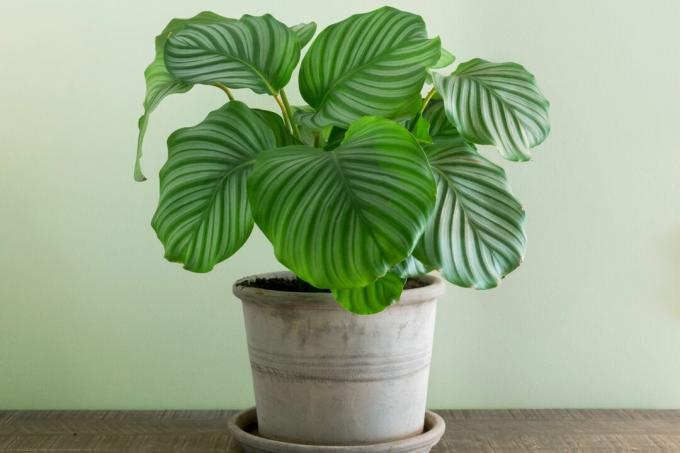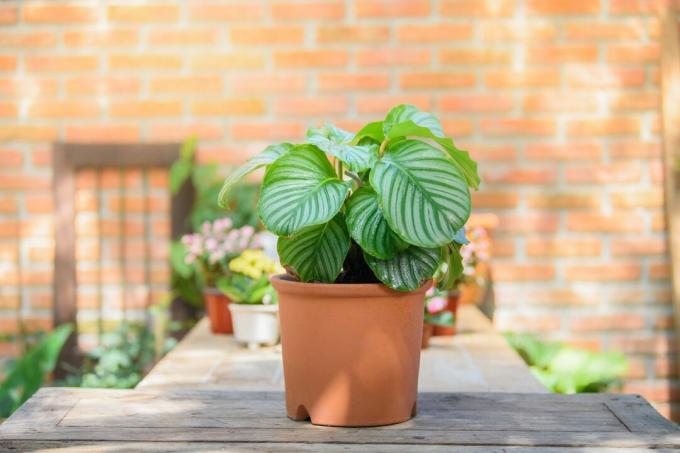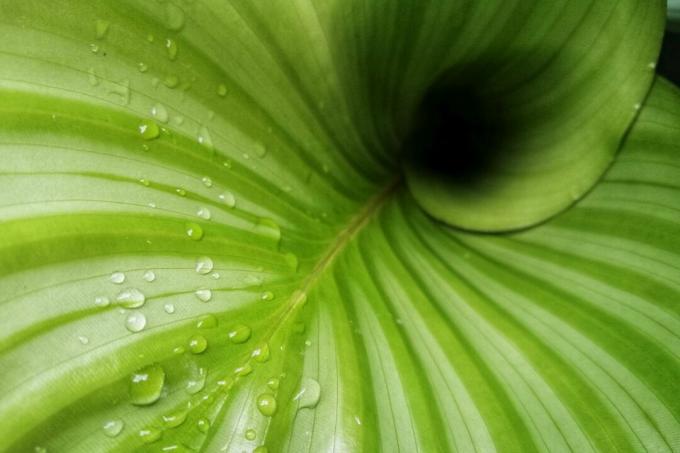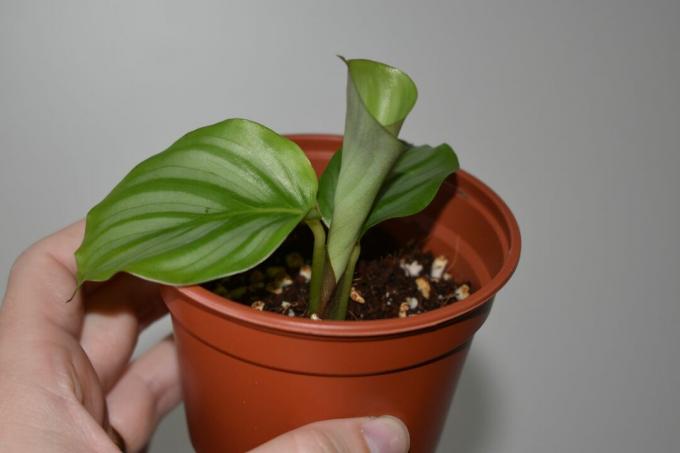The special thing about the Calathea orbifolia are probably their large, striped leaves. However, the beautiful foliage plant is more for advanced houseplant gardeners.

A high level of humidity, even heat and soil moisture as well as nutrients are among the basic requirements for a healthy Calathea orbifolia. Anyone who meets these needs of the jungle plant and offers a suitable location will have great pleasure in the extraordinary plant.
contents
- Calathea orbifolia: origin and characteristics
- Location, soil and co. for the houseplant
-
Caring for Calathea orbifolia
- Water, cut and fertilize
- Common nursing mistakes and their treatment
- Propagating Calathea orbifolia
- Is Calathea orbifolia poisonous?
Calathea orbifolia: origin and characteristics
the Calathea orbifolia belongs to the genus of basket marants (calathea) and comes from the tropical forests of South America. She is one of many calathea-Species, which are excellent to keep as a houseplant. Its showy foliage makes it a decorative foliage plant. The leaves are juicy light green with silvery-green stripes. They grow up to 40 cm tall and have a rounded shape with a slightly wavy edge. Hence the botanical name, because
orbifolia means something like "round-leaved". The leaves move during the day and curl up at night. The herbaceous plant grows to a height of about 80 cm. The star-shaped white flower of the Calathea orbifolia usually does not appear in indoor plants. As a non-hardy plant, it can already be damaged from 5 °C.
Location, soil and co. for the houseplant
According to their natural location in the rainforest, the Calathea orbifolia be placed in a light semi-shade place. It needs a lot of indirect light, but must not be in the direct sun. High humidity is also important. This can be found, for example, in a bright bathroom behind a light curtain. But you can also take care of it yourself by filling a trivet with expanded clay and water. The pot with the basket marante is placed on it so that the water evaporates in the immediate vicinity. A year-round, average room temperature of 18 to 26 °C is for the Calathea orbifolia ideal. In winter it must not be colder than 15 °C.
The right soil is above all humus, but should be sufficiently coarse-pored so that the water can drain off well. A suitable substrate is ours, for example Plantura organic universal soil, which with its coarse structure made from sustainably obtained organic raw materials and the slightly acidic pH value optimally suits the needs of tropical indoor plants. It also contains no peat and is equipped with nutrients for the first few months. By mixing in 30% expanded clay, the soil can be made even more permeable. Expanded clay is also good for creating a drainage layer on the bottom of the pot. In this way, excess water can drain off directly and there is no risk of damaging waterlogging.
Since the Calathea orbifolia If you need an evenly moist soil without waterlogging, it is advisable to also create a mulch layer on the substrate. For example, our is suitable for this Plantura organic pine bark, which has a nice rust-brown color and prevents the water from evaporating from the soil too quickly. The pine mulch layer keeps the moisture in the soil and also helps to prevent unwanted growth from the substrate.
Caring for Calathea orbifolia
The care of Calathea orbifolia is not very uncomplicated. In the summer she can Calathea orbifolia also stand outside in the shade, where it can easily cover its minimum light requirement of 750, better 2000 lux light intensity. But even outside, regular moistening of the leaves must be ensured.
Tip: Not only does the high humidity help keep the plant healthy, but it also keeps out a variety of pests that tend to prefer dry air.
Water, cut and fertilize
Since it requires a moist substrate, it is important that Calathea orbifolia to water regularly. Water that is low in lime is used for this purpose, ideally even rainwater. As soon as the top 2 cm of soil has dried, it should be watered again. This can easily be checked with a finger test. Excess irrigation water should be removed about 15 minutes after watering, as the calathea must never stand in water. In winter, because of the lower temperatures and less daylight, less water is poured, but the root ball should always be slightly moist.

In the growing season from spring to autumn you should Calathea orbifolia fertilize. A fertilizer application with liquid fertilizer, such as ours Plantura organic indoor & green plant fertilizer, half the dosage is sufficient about every four weeks. With sufficient nitrogen and reduced phosphate content, our organic fertilizer ensures healthy basket marants. The bacteria it contains also strengthen the roots. Since the Calathea orbifolia If you need an even supply of nutrients, our primarily organic fertilizer is ideal: Because the nutrients are only available after they have been implemented in the soil and are thus gradually available Disposal.
If the leaves turn yellow and are old and dried up, you can grab the scissors and the Calathea orbifolia to cut. However, pruning for branching or before winter is not necessary.
A repot of Calathea orbifolia is only necessary when the roots grow out of the pot. Otherwise, it is enough to replace the top layer of substrate annually, because repotting can calathea stress unnecessarily. It is best to repot in spring, when the growing season begins. The roots should be treated with care, dead and rotted roots are cut off and the old soil removed before the calathea planted in a next larger pot. When repotting, the Calathea orbifolia be multiplied by division, which we explain in more detail below.

Common nursing mistakes and their treatment
- Calathea orbifolia has brown edges: Brown edges or spots on the leaves of the calathea are usually a sign of too low a soil pH or too much nutrients. In this case, it is best to repot the plant in fresh, suitable substrate.
- Calathea orbifolia leaves hanging: The calathea moves its leaves throughout the day, so drooping leaves aren't necessarily a bad sign. However, if they are also discolored and limp, hanging leaves can be a sign of dry or, vice versa, wet substrate. Check the soil and replace the top layer of substrate if necessary. Older soil tends to collapse and eventually becomes less able to absorb and store water. Disease of the roots, lack of light, dry air or drafts can also lead to drooping leaves.
- Yellow leaves: Get the Calathea orbifolia wilted and yellow leaves, then she is probably suffering from root rot. This is caused by waterlogging, i.e. when the irrigation water cannot drain properly. In this case, the calathea repotted in fresh substrate and freed from rotten roots. Be sure to lay a drainage layer when planting and always drain excess water after watering. In addition, a lack of nutrients due to a lack of fertilizer or too much light can be the reason for yellow leaves.

Tip: If a wicker tree curls up its leaves at night, this is not a sign of improper care, but quite natural. It adapts to the lighting conditions.
Propagating Calathea orbifolia
Similar to the care is also the propagation of the calathea not very easy. While it is possible that Calathea orbifolia to propagate by division - however, there is a risk of injuring the sensitive roots too much. If you still want to venture into propagation, you should have a healthy mother plant and divide it in late spring. Repotting is the ideal time.
- the calathea remove from the pot, remove the soil from the roots.
- With a sharp and clean knife, cut off a small piece from the mother plant, consisting of at least one leaf and some roots. Accidentally damaged roots must be removed at the base so that new roots can sprout at this point - because the calathea cannot "fix" it.
- Plant the young plant in its own pot that contains well-drained, nutrient-poor substrate.
- For example, ours is suitable Plantura Organic Herb & Seed Soil, which is equipped with fewer nutrients for the cultivation of young plants. This promotes the formation of strong roots. For more permeability, 30% broken expanded clay should be mixed in.
- Keep the soil moist and place the plant in a rather shady position at 24 to 30°C. It should also be covered with a clear plastic bag that is aired daily.
- If new leaves form, propagation has been successful and the plastic bag is omitted and replaced with daily misting.
- During the vegetation period, it is now fertilized like an adult calathea.
- Next spring it can be repotted in nutrient-rich substrate.

Is Calathea orbifolia poisonous?
no, the Calathea orbifolia is non-toxic and safe to keep in homes with children and pets. However, it should not be consumed because it is not a useful plant.
Whom the silver-colored pattern on the leaves of the Calathea orbifolia agrees, he will probably also like syngonium -another foliage plant that can be used as a climbing plant in the room.


